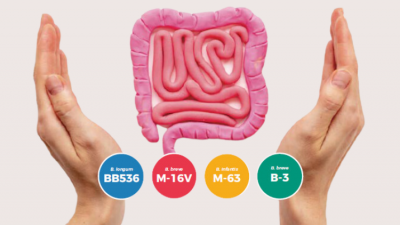Promotional Features
How to pick an infant health probiotic strain that meets demands for effectiveness and naturalness
Parents are demanding more from infant nutrition products. With research implicating the microbiome in the rise in early-life complications and chronic health conditions, there is a fast-growing opportunity for products that help to maintain a healthy gut microbiota in early childhood.
Yet, brands need to take care when choosing probiotic strains for infant use to ensure their products are baby friendly and meet consumer demands for naturalness.
Almost 15% of babies born in 2015 suffered from low birth weight, raising their risk of stunted growth, lower IQ and chronic conditions such as obesity and diabetes1. Almost half of the births happened in Southeast Asia. Equally, the number of overweight and obese children is rising. Around 41 million people under the age of five are now overweight or obese2.
Researchers have linked the microbiome to the trends. The links start in the womb, with dysregulation of the maternal gut microbiome associated with low birth weight3. Other studies have associated early-life development of the gut microbiome with conditions including type 2 diabetes, obesity and allergies4.
The data, coupled to evidence of the positive effects of a balanced microbiome, are driving parents to look beyond vitamin and mineral fortification when considering maternal and infant nutrition. Parents are increasingly seeking out products that use pre- and probiotics. At the same time, interest in natural and organic baby food is on the rise.
Why strain selection matters
Manufacturers have responded to the trends by fortifying infant formula, baby food and supplements with probiotics such as bifidobacteria. The industry response to the trends raises two questions: Are the probiotic-fortified products as good for babies as they could be? And how do we define the naturalness of probiotic strains?
The questioning of the effectiveness of probiotic-fortified infant products is underpinned by evidence of differences between the effects of strains. Specifically, bifidobacteria can be split into two main groups, human-residential bifidobacteria (HRB) and non-HRB. Non-HRB are naturally found in animal intestines, sewage and foods, rather than in humans.
HRB are further divided into infant- and adult-type bifidobacteria. Infant-type HRB include B. breve, B. longum subsp. infantis, B.longum subsp. longum and B. bifidum. The infant gut population is shaped by human milk oligosaccharides (HMOs), components of breastmilk that have no direct nutritional value but selectively promote growth of HRB species. Antibacterial compounds such as lactoferrin and lysozyme in breast milk are other possible selective factors for HRB.
The research into the groups of bifidobacteria feed into the question of how to define the naturalness of probiotics. Many consumers want “natural” products but how the term is defined in the context of probiotics remains an open question. If a probiotic originated outside of humans, is it “natural” to use the strain in infants?
Questions about the effectiveness and naturalness of probiotics are interlinked. Because infant-type HRB strains are naturally selected by HMOs and other molecules in human breast milk, they may be more effective as probiotics. Research into that hypothesis is moving the probiotic industry beyond strain specificity. Increasingly, researchers are showing the origin of a bacterium can influence how it interacts with the human host.
Clinically validating HRB in infants
Research into B. longum BB536 points to the potential power of infant-type HRB. BB536 was discovered in the gut of a healthy breast-fed infant in 19695. Since then, the strain has been used in a range of foods and supplements, including infant formula, and secured Generally Recognized As Safe status from the US FDA (GRN No. 268 and GRN No. 877)6,7.
In recent years, researchers have shown the effects of the strain on infant health. One clinical trial randomized healthy newborns to take formula supplemented with BB536 or with no supplementation8. The amount of bifidobacteria and the ratio of bifidobacteria to enterobacteriaceae, a strain associated with gut dysbiosis, were significantly higher in the BB536 supplementation group at months 2 and 4. The trial also generated evidence BB536 improves the development of the T helper immune response.
A second clinical trial randomized 520 children aged two to six years to receive a sachet of BB536 or placebo once a day9. After 10 months, the researchers saw a significant difference between the BB536 and placebo groups in the rate of respiratory illnesses. The duration of sore throat in the BB536 arm was 46% lower than in the control group.
The clinical trials support the idea that the close relationship between BB536, a HRB, and the infant host differentiates the probiotic strain in early-life applications. BB536 is tolerant to the antibacterial enzyme lysozyme, making a good fit for use while breastfeeding10. While non-HRB stains cannot survive in breast milk, BB536 thrives. Equally, the strain works in conjunction with lactoferrin, a component of breastmilk10. Used together, BB536 and lactoferrin can bring infant formula even closer to breastmilk, in terms of adding natural probiotics and components of breastmilk.
Manufacturers that want to bring those benefits to consumers can leverage Morinaga Milk Industry’s research into the strain and other HRB. In doing so, companies can address growing parental demands for validated, natural infant nutrition products and thereby help give infants a good start in life.
References
[1] Low birthweight. UNICEF DATA https://data.unicef.org/topic/nutrition/low-birthweight/ (2018).
[2] Noncommunicable diseases: Childhood overweight and obesity. https://www.who.int/news-room/questions-and-answers/item/noncommunicable-diseases-childhood-overweight-and-obesity.
[3] EBioMedicine. The maternal microbiome: another bridge linking mothers and infants. EBioMedicine 71, 103602 (2021).
[4] Wong, E., Lui, K., Day, A. S. & Leach, S. T. Manipulating the neonatal gut microbiome: current understanding and future perspectives. Arch. Dis. Child. Fetal Neonatal Ed. 107, 346–350 (2022).
[5] Wong, C. B., Odamaki, T. & Xiao, J.-Z. Beneficial effects of Bifidobacterium longum subsp. longum BB536 on human health: Modulation of gut microbiome as the principal action. J. Funct. Foods 54, 506–519 (2019).
[6] GRAS Notices. FDA https://www.cfsanappsexternal.fda.gov/scripts/fdcc/?set=GRASNotices&id=268&sort=GRN_No&order=DESC&startrow=1&type=basic&search=bifidobacterium.
[7] GRAS Notices. FDA https://www.cfsanappsexternal.fda.gov/scripts/fdcc/?set=GRASNotices&id=877&sort=GRN_No&order=DESC&startrow=1&type=basic&search=bifidobacterium.
[8] Wu, B.-B., Yang, Y., Xu, X. & Wang, W.-P. Effects of Bifidobacterium supplementation on intestinal microbiota composition and the immune response in healthy infants. World J. Pediatr. 12, 177–182 (2016).
[9] Lau, A. S.-Y. et al. Bifidobacterium longum BB536 alleviated upper respiratory illnesses and modulated gut microbiota profiles in Malaysian pre-school children. Benef. Microbes 9, 61–70 (2018).
[10] Egashira, M., Takayanagi, T., Moriuchi, M. & Moriuchi, H. Does daily intake of bovine lactoferrin-containing products ameliorate rotaviral gastroenteritis? Acta Paediatr. 96, 1242–1244 (2007).









